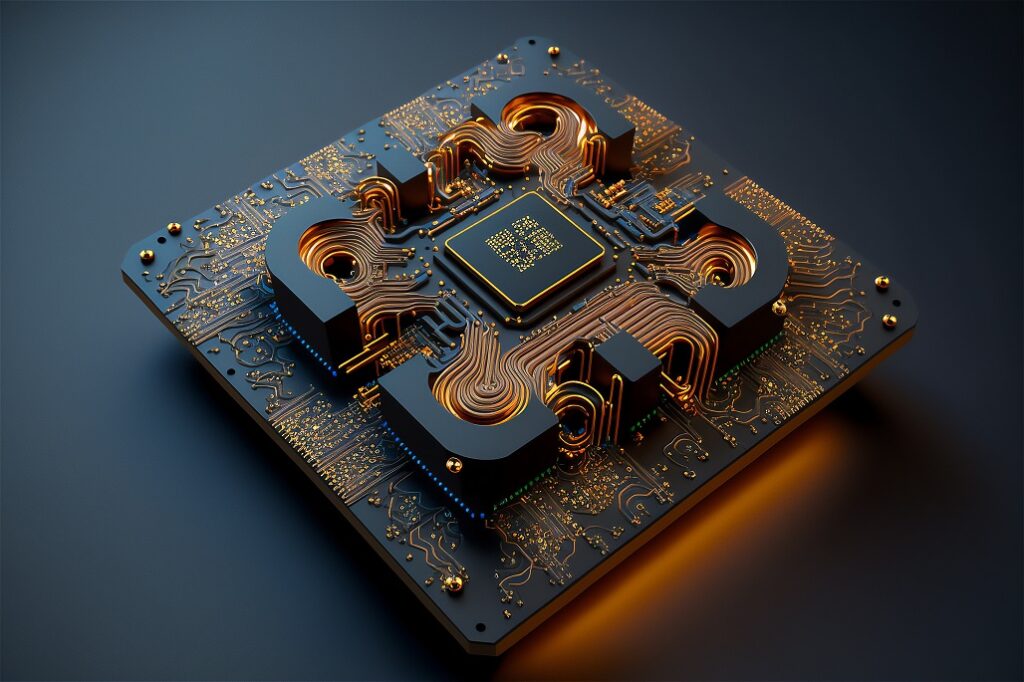Introduction
The moments of transformation in the semiconductor industry often arrive quietly — until they don’t. In 2025, Qualcomm made one such bold move: the company announced its entry into the AI infrastructure market, formally entering the Qualcomm AI chip race. With new products unveiled and its stock surging, Qualcomm is positioning itself as a serious challenger to the dominance of Nvidia and AMD. In this piece we’ll analyse what Qualcomm is doing, why this matters, how it affects the wider AI chip race, and what it means for investors and the tech landscape.

Qualcomm AI chip race ignites: Stock surges on big announcement
The Qualcomm AI chip race kicked into high gear when Qualcomm’s shares rose more than 20% in a single day after it announced new AI accelerator chips and rack-scale server solutions. According to Yahoo Finance, the stock “spikes more than 20% as company enters AI chip race, taking on Nvidia, AMD.” This dramatic move underscores how the market views Qualcomm’s pivot into AI infrastructure. The surge signals investor conviction that the Qualcomm AI chip race isn’t just rhetoric — it’s a strategic bet.
What’s Qualcomm’s play? The AI200 & AI250 chips lead the way in the Qualcomm AI chip race
The heart of the Qualcomm AI chip race strategy lies in the two new chips: the AI200 and AI250. Qualcomm announced that the AI200 will be available in 2026 and the AI250 in 2027. These chips are designed for AI inference (i.e., executing already-trained models) rather than training new models — a critical distinction in the AI chip race. Key features include massive memory per card (up to 768 GB) and improved power efficiency — both important for data-center scale AI workloads. By entering the Qualcomm AI chip race, Qualcomm aims to claim a slice of the multi-trillion-dollar data-center infrastructure market.

Why the Qualcomm AI chip race matters: Challenging Nvidia & AMD
For years, Nvidia and AMD have dominated the AI infrastructure space, especially in training and inference hardware. By entering the Qualcomm AI chip race, Qualcomm is signalling that it intends to compete directly, not just in mobile chips (its traditional domain) but at the heart of cloud and enterprise AI.
This move matters for several reasons:
- Market diversification: Rivaling the incumbents opens up choice for hyperscalers and enterprise customers.
- Power & efficiency: Qualcomm’s mobile legacy gives it experience in power-efficient chips, a key edge in inference workloads.
- Platform stack: Qualcomm is offering not just chips, but racks, accelerator cards and supporting software — a full-stack play in the Qualcomm AI chip race.
- Stock and valuation implications: Investors responded positively, seeing the announcement as a pivot to higher-growth infrastructure, fuelling the stock surge.
Thus, the Qualcomm AI chip race is not just about products — it’s about strategy, market repositioning and long-term growth.
How does Qualcomm stack in the AI chip race? Strengths & challenges
In the context of the Qualcomm AI chip race, Qualcomm brings several strengths:
- Deep expertise in NPUs and mobile silicon (which can translate to inference workloads)
- More power-efficient architectures (important for data-center TCO)
- A large installed base and ecosystem presence
- A full stack offering (chips + racks + software)
However, there are important caveats:
- Qualcomm enters the race later than Nvidia/AMD, which already dominate market share.
- Launches are scheduled for 2026/2027 — meaning near-term results may be modest.
- Execution risk: Delivering high performance chips plus ecosystem and customer wins is complex.
In short, the Qualcomm AI chip race gives the company a seat at the table — but success will depend on execution, differentiation and market traction.
Investor implications: What the Qualcomm AI chip race means for QCOM stock
For investors tracking the Qualcomm AI chip race, a few points stand out:
- The stock’s sharp rise reflects optimism about Qualcomm’s future beyond smartphones.
- If Qualcomm captures meaningful share in the AI infrastructure market, the growth runway is sizable — the AI chip race is a high-growth segment.
- But there’s risk: Timing, competition, chip margins, and ecosystem acceptance will determine outcomes.
- For long-term investors, the Qualcomm AI chip race can be viewed as a strategic transformation; for short-term traders, the announcement triggered volatility.
If you hold or are considering QCOM (Qualcomm’s ticker), keep an eye on updates around AI200/AI250 launches, customer wins (like the disclosed deal with Humain), and quarterly commentary on infrastructure growth.
Macro trend: The AI infrastructure wave & Qualcomm’s role in the AI chip race
The broader backdrop of the Qualcomm AI chip race is the massive surge in AI model deployment, generative AI workloads, and demand for inference solutions. According to Reuters, the drive to build infrastructure for large language models and other AI applications is fueling chipmakers’ interest in this segment. Qualcomm’s move aligns with this wave. By targeting inference (rather than just training) and offering full rack solutions, Qualcomm’s part in the Qualcomm AI chip race is positioned where large-scale recurring demand resides. Additionally, their emphasis on cost-efficiency per watt and memory capacity per card (768 GB) shows they are betting on differentiation in the inference arms race.
Strategic Focus & Positioning
Qualcomm
- Qualcomm’s strategy in the AI infrastructure space is to enter the race by launching rack-scale accelerator solutions — specifically the AI200 and AI250 chips — targeting AI inference in data centres.
- These chips emphasise large memory capacity per card (e.g., AI200 supports 768 GB LPDDR) and focus on cost-efficient inference rather than only training.
- Qualcomm is leveraging its experience in NPUs and mobile silicon and aiming to transfer that into enterprise AI infrastructure.
- Time-to-market: AI200 slated for 2026; AI250 for 2027.
Nvidia
Nvidia has been the long-standing leader in the AI accelerator market, especially for training and inference with high end GPUs and full-stack ecosystems (hardware + software + platforms).
Its dominance is driven by its CUDA ecosystem, large installed base, and early mover advantage. It reportedly holds ~80 % of the AI accelerator market.
Nvidia continues to push next-gen architectures (e.g., “Vera Rubin” microarchitecture) and build full solutions for hyperscale deployments.
AMD
- AMD is making strong moves to gain ground in the AI infrastructure domain. For example, it has struck a multi-year deal with OpenAI to supply its upcoming MI450 GPUs starting in 2026.
- AMD emphasises open standards (ROCm software stack), memory capacity and serviceability (e.g., its Helios rack platform claims 50 % more memory than some Nvidia offerings) in its AI infrastructure approach.
- But AMD still lags behind Nvidia significantly in market share and ecosystem depth.
Technological Differentiators & Roadmap
Qualcomm
Key differentiator: Memory per card & near-memory computing (especially with AI250). AI250 claims to offer more than 10× the effective memory bandwidth compared to what Qualcomm was previously doing.
They emphasise energy/power efficiency and cost-effective inference, aiming at enterprises wanting large-model inference at lower cost.
Rack & accelerator card form-factors, with direct liquid cooling and support for large scale deployments.
Nvidia
Offers high-end GPUs (training + inference) with massive compute, ecosystem (software, libraries, frameworks) and broad customer adoption.
Strong software stack: CUDA, ecosystem tools, developer community.
Roadmap: Continuation of high-performance GPU families and integration with other vendors (e.g., partner with Intel) for broad stack.
AMD
Emphasises memory capacity and open ecosystem advantage: example, Helios rack-scale platform for AI with MI450.
Software stack: ROCm (open compute) which appeals to organisations wanting alternatives to closed ecosystems.
While still catching up, its deals (e.g., with OpenAI) signal intent and potential.
Strengths & Weaknesses
| Company | Strengths | Weaknesses |
|---|---|---|
| Qualcomm | Novice in infrastructure but brings mobile/NPU power-efficiency; large memory plans; cost-efficient inference focus. | Late entrant; ecosystem and deployment track‐record limited; actual performance & customer uptake yet unproven. |
| Nvidia | Market leader; mature ecosystem; widely adopted; strong product roadmap and services. | Premium pricing; risk of being challenged by more cost-efficient competitors; high expectations. |
| AMD | Open ecosystem; strong memory and hardware value propositions; strategic partnerships emerging. | Smaller share; ecosystem and software maturity may lag; needs to demonstrate large scale wins. |
Market & Business Implications
In entering the “AI chip race”, Qualcomm is signalling a strategic transformation away from just mobile chips to enterprise AI infrastructure. This is important because the inference market is expected to grow significantly with AI models, generative AI and multimodal workloads.
For Nvidia, its dominance gives it leverage, but also means it must fend off challengers like Qualcomm and AMD, especially on cost, efficiency, and memory architectures.
For AMD, deals such as with OpenAI and its Helios platform show potential to increase market share and provide alternatives in the AI infrastructure stack.
For customers/data-centres: More competition (Qualcomm + AMD) means potential for better pricing, innovation, and options beyond Nvidia’s current dominance.
For investors: The competitive dynamics matter — Qualcomm’s stock rise on its announcement underscores market optimism about its strategy. But success depends on execution.
Outlook: How the “AI Chip Race” Might Play Out
- Time-frame matters: Qualcomm’s chips arrive in 2026/2027; AMD’s deployments in 2026; Nvidia already broadly deployed. The early mover (Nvidia) has advantage.
- Ecosystem & software: Hardware alone isn’t enough. Nvidia has mature software and deployment; Qualcomm and AMD must build or emphasise their stack.
- Cost & efficiency: Qualcomm is betting on inference efficiency and memory per card; If successful this could lower barrier for companies deploying AI models.
- Memory & architecture innovations: Near-memory computing (Qualcomm AI250) and memory-heavy racks (AMD Helios) show that memory bandwidth & capacity are critical in the next gen.
- Customer wins matter: Large contracts (e.g., OpenAI-AMD) or first customers help validate. Qualcomm’s first disclosed deal (e.g., Humain) is a start.
Key Takeaway
- If you view the Qualcomm AI chip race as a shift in competitive balance, then Qualcomm is the new challenger, aiming to disrupt the established players via cost, efficiency and memory architecture.
- Nvidia remains the incumbent, strong and dominant, but challenged.
- AMD is the rising alternative, gaining traction with key deals and hardware innovation.
- For stakeholders (companies building AI infrastructure, investors, tech watchers) this race matters because it influences hardware availability, pricing, innovation pace and who defines the next generation of AI compute.
FAQ Section
Q1. What is the “Qualcomm AI chip race”?
It refers to Qualcomm’s strategic push into the AI infrastructure market — specifically launching the AI200 and AI250 chips and server racks to compete with Nvidia and AMD in AI inference.
Q2. When will Qualcomm’s new AI chips be available?
Q3. Why is Qualcomm focusing on inference rather than training in the AI chip race?
Inference is the process of using trained AI models to generate outputs (e.g., chat responses, image creation). It has massive scale in deployment and recurring usage, making it a strategic target in the AI infrastructure segment. Qualcomm aims to capture this through efficient chips and full-stack solutions in the Qualcomm AI chip race.
Q4. How does Qualcomm vs Nvidia/AMD compare in this AI chip race?
Qualcomm brings power-efficient architectures, large memory per card (e.g., 768 GB), and a full supply stack. However, Nvidia and AMD have head-start, established market share and ecosystems. Qualcomm’s success in the Qualcomm AI chip race will depend on catching up fast, securing customers, and demonstrating performance and cost-efficiency.
Q5. Why did Qualcomm’s stock surge when it entered the AI chip race?
Q6. What are the risks in the Qualcomm AI chip race?
Key risks include delayed launches, insufficient performance relative to competitors, inability to scale manufacturing or ecosystem adoption, and margin pressure in a fiercely competitive market.
Q7. How should investors view the Qualcomm AI chip race?
As a strategic transformation with long-term upside, but with near-term execution risk. For those bullish on AI infrastructure growth and diversification, Qualcomm is a play. If you prefer more established players, you may want to watch how Qualcomm executes first.
Conclusion
The Qualcomm AI chip race is more than just a marketing slogan — it represents Qualcomm’s ambition to move from mobile silicon to large-scale AI infrastructure. With its AI200 and AI250 chips, full-stack server solutions, and initial customer wins, Qualcomm has officially entered the arena where Nvidia and AMD have dominated. For investors, the stock surge signals belief in this shift. For the AI industry, more competition means innovation, cost pressure, and potentially faster evolution of infrastructure. As Qualcomm writes the next chapter in the AI chip race, both the journey and the outcome will be worth watching closely.
+ Best Telecom Data Settlement Secrets : Don’t Miss Your Benefit AT&T $177M
+ iPhone 16 Pro Reduced Price : Major Festival Sale Slashes Flagship Costs
+ Motorola Edge 70 : The Ultra-Slim Smartphone That Redefines Flagship Design






